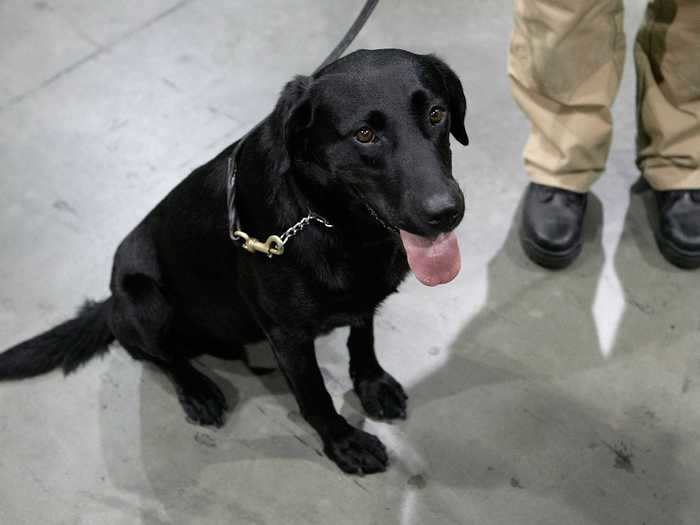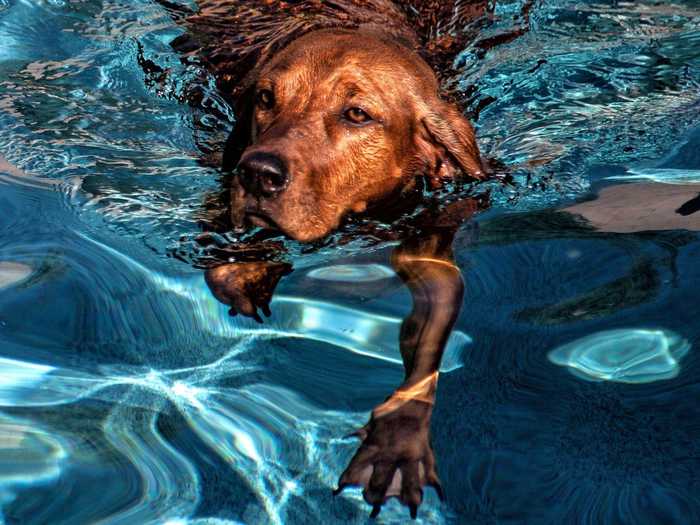It's especially important to keep an eye on your pets during warm weather months.
High temperatures can cause your furry friend to experience life-threatening heatstroke, and even the warm-weather activities you do can cause distress to your pet.
Keep reading for tips on how to keep your pets happy, healthy, and safe as temperatures go up.
Don't cover your pet in sunscreen or bug spray that's meant for humans.
Animals shouldn't be consuming sunscreen.
Shutterstock
"Do not apply any sunscreen or insect repellent product to your pet that is not labeled specifically for use on animals," said Lori Bierbrier, medical director of community medicine at ASPCA.
Yes, it's true that most mammals are susceptible to sunburn and bug bites. But that doesn't mean you should be covering your dog with the same stuff you use on yourself. Many sunscreens and insect repellents contain ingredients that are harmful if eaten.
Remember, your pet does not understand what these products are or why they're used. If you choose to cover their skin with it, there's a good chance they'll want to investigate using their sense of smell or taste.
Bierbrier told Insider, "Ingestion of sunscreen products can result in drooling, vomiting, diarrhea, excessive thirst and lethargy, while misuse of insect repellent that contains DEET can lead to neurological problems."
Instead, look for a sunscreen or bug spray that is designed specifically for animal use. These usually don't contain the same ingredients as human versions. However, be wary that some sprays that work for dogs may be toxic to cats.
Once you find the appropriate product, read the instructions and test it on a small patch of your pet's skin before applying. This will allow you to check for allergic reactions.
If you have any concerns about your pet's health in the heat, consult your veterinarian.
Never take your pet on an outdoor adventure without bringing plenty of water.
Be sure to bring a bowl for your pet, too.
iStock
Like humans, pets are susceptible to dehydration if they don't drink enough water.
If you're going to be participating in outdoor activities, like camping, it's imperative that you always have water available for your pet to drink. You may also want to bring a small bowl for your pet to drink out of, too.
Over the course of the day, dogs need to drink one half to one ounce of water for every pound of bodyweight they have. Don't wait for your pet to appear thirsty or beg.
Don't ignore the signs of heatstroke.
Catching a heatstroke early can save your dog's life.
Alex Wong/Getty Images
Heatstroke is a life-threatening, medical emergency marked by an inability to cool down the body's temperature. Since dogs don't have sweat glands dispersed throughout their body like humans, they regulate their temperature by panting.
On the other hand, cats keep cool by using their own saliva and licking their body.
Both dogs and cats, along with rabbits, guinea pigs, and other rodents, are susceptible to developing heatstroke. If left untreated, this condition can cause severe, potentially irreversible damage to your pet's organs.
Some signs of heatstroke in dogs include seizures, stupor, and delirium-like behavior. Cats may show signs of heat-related distress through excessive grooming, weakness, or redness in their tongue.
If you notice any of these in your pet, immediately contact your vet.
Try not to walk your dog during the hottest time of day whenever possible. Instead, walk your dog during the evening.
Bring your dog on a long walk once the sun has begun to set.
MikeDotta/Shutterstock
Avoid bringing your pet outside for extended periods of time when the temperature is high.
If you're bringing your pet outside, ensure they have water and access to a shaded area.
Shutterstock
For pets, exposure to high-temperature environments can quickly become a serious problem and lead to heatstroke.
Remember, they can't regulate temperatures the same way humans can, so it's important that you limit their time in extremely hot environments.
This means if you're going to be out at work or running errands, consider bringing them inside. And if your pet has to remain outside, make sure they have plenty of shade and water.
Don't leave your animal unattended when they're near bodies of water.
Even if your dog can swim, don't leave them alone near a pool.
Shutterstock
Be wary of leaving your pets unsupervised near swimming pools, especially in your own backyard. Not all pets know how to swim just because they're an animal, and a single tumble into the deep end can quickly turn into a tragedy if you aren't around.
If you're bringing your pet around water for the first time, gradually ease them into it. Never throw any animal into any body of water against their will. Not only does this scare them, but also it could be dangerous if they aren't a strong swimmer.
And if you plan on taking your pet for a boat ride, be sure they're wearing a life vest, too.
Read More:






